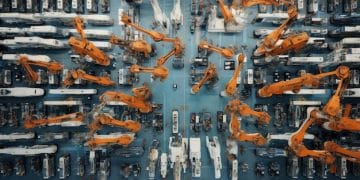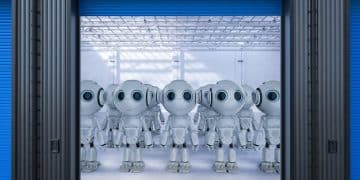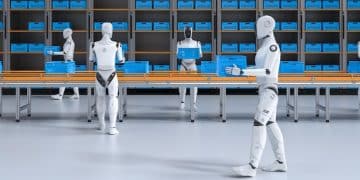US Robotics Standards 2025: Impact on Automation Adoption
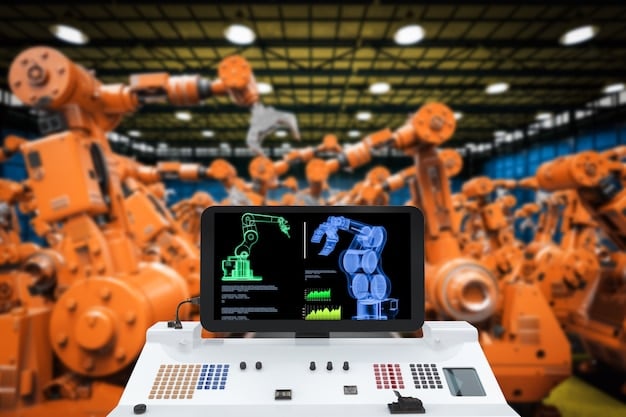
The updated US robotics standards in 2025 are poised to significantly influence automation adoption by enhancing safety, fostering innovation, and streamlining regulatory compliance across various industries, impacting both large enterprises and emerging businesses.
How Will the Updated US Robotics Standards Impact Automation Adoption in 2025? As the United States continues its rapid integration of automation across industries, the robustness and clarity of its regulatory frameworks become paramount. The year 2025 is set to be a pivotal moment, with significant updates to robotics standards expected to redefine the landscape of automated systems. This evolution demands a closer look into their potential to catalyze or constrain the wider adoption of robotic technologies, from manufacturing floors to service sectors, and from healthcare facilities to logistics hubs.
Understanding the Evolution of US Robotics Standards
The journey toward comprehensive robotics standards in the US has been incremental, driven by rapid technological advancements and an increasing awareness of safety, ethical, and operational considerations. Early standards primarily focused on industrial robotic arms, often in caged environments, ensuring worker safety through physical separation and emergency stop mechanisms. However, the proliferation of collaborative robots (cobots), autonomous mobile robots (AMRs), and AI-driven systems necessitates a more nuanced and expansive regulatory approach. These updated standards for 2025 are not merely revisions; they represent a fundamental shift in how robotic systems are designed, deployed, and interacted with in diverse human-centric environments. This shift acknowledges the complexity of human-robot interaction and the need for adaptable, intelligent safety protocols rather than rigid, static ones.
Historical Context and Key Drivers for Change
Historically, organizations like the American National Standards Institute (ANSI) and the Robotics Industry Association (RIA), now part of the Association for Advancing Automation (A3), have been at the forefront of developing guidelines. ANSI/RIA R15.06, for example, has been a cornerstone for industrial robot safety. Yet, the advent of Industry 4.0 and the imperative for greater operational flexibility have underscored the limitations of these legacy standards. The new wave of regulations is being shaped by several key drivers. There’s a persistent demand for improved worker safety as robots move beyond segregated zones and into direct collaboration with humans, alongside an urgent need for interoperability to facilitate complex multi-robot systems and data exchange. Ethical considerations, including data privacy and algorithmic bias, are also playing an increasingly prominent role in shaping these modernized frameworks, aiming for long-term societal compatibility.
- Enhanced Safety Protocols: Moving beyond physical barriers to incorporate advanced sensor systems and AI-driven risk assessment.
- Interoperability and Connectivity: Standards facilitating seamless communication between various robotic systems and broader IT infrastructures.
- Ethical AI Integration: Addressing concerns related to data privacy, algorithmic transparency, and responsible autonomy.
- Performance Benchmarking: Establishing common metrics for evaluating robot capabilities and reliability across applications.
The Role of National and International Bodies
The development of US robotics standards does not occur in a vacuum. It is heavily influenced by international efforts, particularly from organizations such as the International Organization for Standardization (ISO) and the International Electrotechnical Commission (IEC). The harmonization of US standards with these global benchmarks is crucial for American manufacturers, enabling them to compete effectively in the international market without the burden of highly divergent regulatory requirements. This includes aligning on definitions, testing methodologies, and performance criteria, which simplifies export and compliance for companies operating globally. Domestically, government agencies like the Occupational Safety and Health Administration (OSHA) also play a critical role in enforcing compliance and providing workplace safety guidelines, often incorporating aspects of these voluntary consensus standards into their regulations. The collaborative dialogue between industry, academia, and government is essential to create standards that are both technologically sound and practically implementable, ensuring they keep pace with innovation while addressing real-world needs.
Key Pillars of the Updated Robotics Standards for 2025
The updated US robotics standards expected by 2025 are built upon several foundational pillars designed to address the multifaceted challenges and opportunities presented by advanced automation. These pillars aim to create a more secure, efficient, and ethically sound environment for robotics deployment. From robust safety measures to enhanced data security, each element plays a crucial role in shaping the future of automation adoption. The intricate details of these standards will likely reflect a careful balance between enabling technological progress and safeguarding human interests and societal values. They require an understanding of complex engineering principles, cybersecurity threats, and the legal implications of autonomous decision-making.
Advanced Safety and Human-Robot Interaction (HRI)
One of the most significant advancements lies in the area of safety, particularly in human-robot interaction. As robots become more integrated into shared workspaces, traditional safety mechanisms are no longer sufficient. The new standards emphasize dynamic risk assessment, predictive safety features, and intuitive human-robot communication to prevent accidents proactively. This includes requirements for sophisticated sensor arrays that can detect human presence and movement, advanced algorithms that enable robots to adjust their behavior in real-time, and clear protocols for emergency stops that are easily accessible to human operators. The goal is to move beyond mere collision avoidance to a state of collaborative intelligence, where robots can anticipate and respond to human intentions, making shared workspaces not just safe, but also more productive and harmonious.
Cybersecurity and Data Integrity in Robotic Systems
The interconnected nature of modern robotic systems presents new vulnerabilities, making cybersecurity a critical component of the updated standards. Robots are increasingly connected to enterprise networks and the internet, making them potential targets for cyberattacks that could lead to data breaches, operational disruptions, or even physical harm. The 2025 standards are expected to include stringent requirements for software security, secure data transmission protocols, and regular vulnerability assessments. This will cover the entire lifecycle of a robotic system, from design and manufacturing to deployment and maintenance, ensuring that data integrity is maintained at every stage. Special attention is also being given to the protection of intellectual property embedded in robotic algorithms and the safeguarding of sensitive operational data collected by these systems.
Performance Benchmarking and Interoperability
Establishing clear performance benchmarks and promoting interoperability are vital for accelerating automation adoption. Businesses need reliable metrics to evaluate the effectiveness and return on investment of robotic deployments. The updated standards will likely define common testing procedures and performance indicators, allowing for standardized comparisons across different robotic platforms and manufacturers. This transparency helps foster competition and encourages innovation within the industry. Furthermore, interoperability standards will enable different robotic systems—even from various vendors—to communicate and cooperate seamlessly, facilitating the creation of more complex and integrated automated workflows. This capability is crucial for scaling automation efforts and achieving the full potential of smart factories and interconnected supply chains.
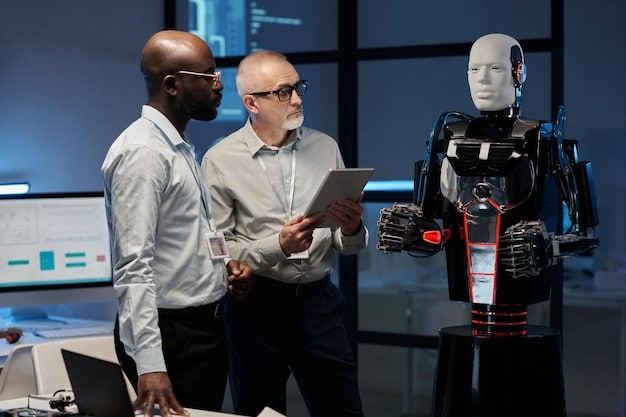
Ethical Guidelines and Accountability Frameworks
As robots become more autonomous and intelligent, ethical considerations and accountability frameworks are gaining prominence. The 2025 standards are anticipated to include guidelines addressing issues such as algorithmic bias, transparency in decision-making, and the ethical implications of autonomous systems in critical applications. This involves ensuring that robotic systems do not perpetuate or amplify existing societal biases, that their decision-making processes can be understood and audited, and that there are clear lines of responsibility in the event of an error or malfunction. Developing these ethical guidelines requires a multi-stakeholder approach, involving ethicists, legal experts, policymakers, and engineers, to create a framework that balances technological progress with societal well-being and trust.
Anticipated Impact on Automation Adoption in 2025
The impending updates to US robotics standards are expected to send ripples across industries, dramatically influencing the pace and nature of automation adoption by 2025. These changes are not merely technical adjustments; they represent a strategic re-evaluation of how robotic technologies integrate into society and the economy. The ramifications will be felt from the design labs of robotics manufacturers to the shop floors of small businesses, and from investor decisions to workforce training programs. Companies will need to adapt quickly, both in terms of their technological capabilities and their operational processes, to remain competitive and compliant in this evolving landscape. The overarching goal is a more mature and responsible automation ecosystem.
Stimulating Innovation and Market Growth
Paradoxically, stricter standards can often fuel innovation. By setting higher bars for safety, performance, and ethical considerations, these updated standards will push manufacturers to develop more sophisticated, reliable, and user-friendly robotic systems. This drive for excellence can lead to breakthroughs in areas such as advanced sensing, AI-driven decision-making, and intuitive human-robot interfaces. Furthermore, clearer guidelines provide a more stable regulatory environment, which in turn reduces uncertainty for investors and encourages greater capital allocation towards robotics research and development. Standardized testing and certification processes will also build greater market confidence, allowing end-users to more easily distinguish between compliant and non-compliant products, ultimately fostering a healthier and more competitive market.
- Reduced R&D Uncertainty: Clearer standards provide a roadmap for developers, streamlining design and testing phases.
- Increased Investor Confidence: A stable regulatory environment attracts more funding into robotics startups and established companies.
- New Product Categories: Standards for advanced HRI may open doors for entirely new types of collaborative robots and service bots.
- Global Competitiveness: Harmonized standards enhance the export potential of US-made robotic technologies.
Challenges for Small and Medium-sized Enterprises (SMEs)
While large corporations with significant R&D budgets may adapt relatively smoothly, small and medium-sized enterprises (SMEs) could face substantial challenges. The cost of upgrading existing robotic systems to meet new standards, acquiring new compliant machinery, and training staff on updated safety protocols could be prohibitive for many smaller businesses. This could create a barrier to entry or expansion, potentially widening the technology gap between large and small players. Policymakers and industry associations will need to consider support mechanisms, such as subsidies, grants, or simplified compliance pathways, to ensure that SMEs are not left behind in the automation revolution. Educational initiatives and accessible resources will also be crucial for helping SMEs navigate the complexities of the new regulatory landscape without being overwhelmed.
Implications for Workforce Training and Job Creation
The updated standards will inevitably have a profound impact on workforce training and job creation. As robots become more sophisticated and integrated, the demand for workers with specialized skills in robotics operation, maintenance, programming, and safety compliance will increase. This necessitates a proactive approach to education and vocational training, ensuring that the existing workforce can upskill and reskill to meet these new demands. While some routine tasks may be automated, new roles will emerge in areas such as robot supervision, data analysis for automated systems, and ethical AI auditing. The standards, by emphasizing safe and effective human-robot collaboration, will also help to reshape the nature of work, fostering environments where humans and robots augment each other’s capabilities rather than competing directly for roles.
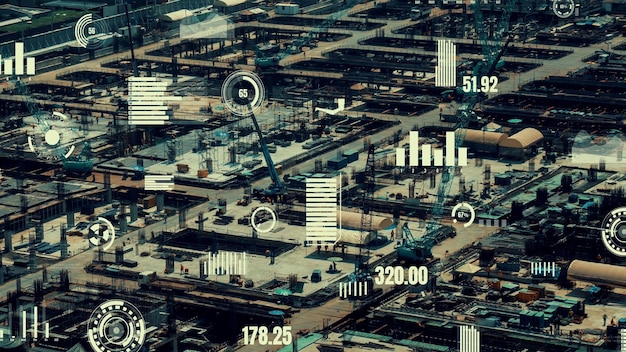
Navigating Compliance: A Roadmap for Businesses
For businesses keen on integrating or expanding their use of automation, understanding and navigating the updated US robotics standards will be paramount. Compliance is not merely a legal obligation; it is a strategic imperative that can enhance safety, improve efficiency, and build trust among employees and stakeholders. Proactive engagement with these standards will enable companies to mitigate risks, avoid costly penalties, and leverage the full potential of their robotic investments. A well-defined roadmap for compliance will involve multiple internal and external facets, demanding a holistic approach that permeates all levels of an organization.
Assessing Current Systems and Identifying Gaps
The first critical step for any business is a thorough assessment of its existing robotic systems and automation infrastructure. This involves a detailed audit of hardware, software, operational protocols, and safety procedures against the new 2025 standards. Key questions to address include: Do our existing robots meet the new safety requirements for human-robot interaction? Are our cybersecurity measures robust enough to protect against emerging threats, as outlined in the updated guidelines? Are our data handling practices compliant with new ethical and privacy mandates? Identifying gaps early allows businesses to prioritize areas for improvement, estimate necessary investments, and develop a phased approach to compliance, minimizing disruption to ongoing operations. This process might require engaging external consultants or specialized robotic safety auditors.
Strategies for Upgrading and Adopting New Technologies
Based on the gap analysis, businesses must develop strategies for upgrading existing systems or adopting new compliant technologies. This could involve retrofitting older robots with new sensors, implementing advanced AI-driven safety software, or investing in entirely new generations of collaborative robots. For software, regular updates and patches will be crucial to maintain cybersecurity compliance. When procuring new systems, it will be essential to ensure that suppliers explicitly confirm adherence to the latest standards and provide necessary documentation for audit purposes. Furthermore, exploring modular upgrades or subscription-based services for robotic software and hardware could offer more flexible and cost-effective pathways to maintaining compliance without massive upfront capital expenditure.
Training and Education for a Compliant Workforce
A compliant workforce is as crucial as compliant technology. Businesses must invest in comprehensive training programs tailored to the updated standards. This includes educating engineers and technicians on new installation and maintenance procedures, training operators on advanced human-robot interaction protocols, and ensuring that all employees working near automated systems understand the revised safety guidelines and emergency procedures. Specialized training on cybersecurity best practices for industrial control systems will also be critical for IT and operational technology (OT) staff. Fostering a culture of safety and continuous learning will be key to successful adoption and ongoing compliance. Regular refresher courses and drills will help reinforce these practices, ensuring that the workforce remains agile and responsive to evolving technological and regulatory demands.
Beyond Compliance: Ethical and Societal Considerations
While compliance with updated US robotics standards is a primary concern for businesses, the broader ethical and societal implications of automation extend far beyond mere regulatory adherence. As robotic technologies become more pervasive and sophisticated, their impact on employment, social structures, and individual well-being demands careful consideration. The standards provide a baseline, but true responsible adoption requires a deeper engagement with the moral and human aspects of an increasingly automated world. These considerations are not abstract philosophical debates; they have tangible consequences for how automation is perceived, accepted, and integrated into our daily lives, influencing public policy and technological development alike.
Addressing the “Robot Tax” and Social Safety Nets
The increased adoption of automation driven by clearer standards could exacerbate concerns about job displacement. This has led to discussions around concepts like a “robot tax,” where companies that automate jobs would contribute to social safety nets or workforce retraining programs. While the practicality and efficacy of such a tax are subjects of ongoing debate, the underlying issue of supporting workers whose roles are impacted by automation remains pressing. Governments and businesses will need to collaborate on innovative solutions, perhaps through universal basic income experiments, publicly funded retraining initiatives, or new models of employment that leverage human-robot collaboration effectively. The focus should be on leveraging automation to create a more prosperous society for everyone, rather than just a select few.
Ensuring Equitable Access and Benefits of Automation
Another critical societal consideration is ensuring that the benefits of automation are equitably distributed. There is a risk that without proactive measures, advanced robotic technologies could primarily benefit large corporations and technologically advanced regions, widening existing economic disparities. The updated standards, alongside government policies, could play a role in promoting equitable access—perhaps through incentives for deploying robots in underserved areas, supporting robotics education in public schools, or fostering the development of open-source robotics platforms. This includes ensuring that smaller businesses and marginalized communities can also reap the rewards of increased productivity, improved safety, and enhanced efficiency that automation offers, preventing a two-tiered society where technological advancement only serves a segment of the population.
The Future of Work and Human Flourishing
Ultimately, the updated robotics standards compel us to consider the future of work and how automation can contribute to human flourishing. Beyond mere efficiency, how can robots enhance human capabilities, free up time for creative pursuits, and improve the quality of life? The standards, by emphasizing aspects like ethical AI and responsible human-robot interaction, lay groundwork for a future where technology serves humanity’s highest aspirations. This involves designing robots that are not just tools, but collaborators that augment human intelligence and ingenuity, rather than diminishing them. It will require ongoing dialogue between technologists, social scientists, ethicists, and the public to ensure that the trajectory of automation aligns with a vision of a more just, sustainable, and fulfilling future for all. This long-term perspective is crucial for guiding technological development responsibly.
Case Studies: Early Adopters and Their Journey
Examining the experiences of early adopters provides invaluable insights into the practical implications of robotics standards and their impact on automation adoption. These organizations, often at the forefront of technological integration, serve as testing grounds for new regulations, highlighting both the opportunities and the challenges inherent in weaving advanced robotics into existing operational fabrics. Their journeys offer concrete examples of how updated standards can either streamline deployment, by offering clear guidelines, or necessitate significant overhauls, by introducing new compliance hurdles. These case studies underscore the dynamic interplay between regulatory frameworks and real-world business operations, demonstrating best practices and potential pitfalls for others to learn from.
Automotive Manufacturing: A Pioneer in Automation
The automotive industry has historically been a pioneer in automation, and its experience with evolving robotics standards is particularly instructive. With the advent of more sophisticated cobots and integrated AI-driven systems, manufacturers have had to adapt rapidly. Companies like Ford and General Motors have actively participated in pilot programs to test new safety protocols for human-robot collaboration on assembly lines. Their experience shows that while the initial investment in upgrading to meet new standards can be substantial, the long-term benefits outweigh the costs. Enhanced safety, reduced downtime due to accidents, and improved ergonomic conditions for workers lead to increased productivity and a more engaged workforce. The standards have pushed them towards more flexible manufacturing, allowing faster retooling for new models, and driving innovation in modular robot design and deployment.
Logistics and Warehousing: Rapid Expansion and Standardization Needs
The logistics and warehousing sectors have witnessed explosive growth in automation, particularly with the widespread adoption of autonomous mobile robots (AMRs). Companies such as Amazon and FedEx have had to grapple with the complexities of managing vast fleets of robots in dynamic environments, often alongside human workers. The updated standards for 2025 are particularly relevant here, addressing issues like navigation in shared spaces, interoperability between different AMR brands, and data security for path optimization and inventory management. Early adopters have learned that clear standards are essential for scaling operations efficiently and safely. A lack of standardized charging protocols or collision avoidance mechanisms, for instance, can lead to significant operational bottlenecks and safety hazards. The new regulations provide a framework for these companies to expand their automated operations with greater confidence and predictability, ensuring seamless integration.
Healthcare and Medical Robotics: Precision and Patient Safety
Medical robotics, from surgical assistants to hospital disinfection bots, represents an area where precision and patient safety are paramount. Companies like Intuitive Surgical (with its da Vinci system) have long operated under stringent regulatory scrutiny, but the expanded scope of robotics into non-surgical applications (e.g., patient transport, remote care) presents new challenges. The updated US robotics standards will likely bring clearer guidelines for human-robot interaction in patient care settings, data privacy for health information processed by AI-driven systems, and robust verification and validation protocols for autonomous medical devices. Early adoption in this sector emphasizes that compliance is not just about meeting rules, but about building trust with healthcare providers and patients. The standards help ensure that innovations in medical robotics are deployed responsibly, maximizing clinical benefits while minimizing risks to human life.
The Road Ahead: Preparing for a Standardized Future
As 2025 approaches, the landscape of US robotics is undergoing a transformative shift, guided by updated standards that aim to foster a safer, more efficient, and ethically sound automated future. The path ahead requires proactive engagement from all stakeholders—industry, government, academia, and the public—to ensure that these standards are not just met, but leveraged to their fullest potential. This isn’t merely about ticking boxes; it’s about shaping an ecosystem where innovation thrives responsibly, and where the benefits of automation are accessible and equitable. The “road ahead” is therefore a continuous journey of adaptation, collaboration, and foresight, ensuring the long-term viability and positive impact of robotics on society.
Continuous Review and Adaptation of Standards
The dynamic nature of technological advancement means that robotics standards cannot be static. They require continuous review and adaptation to remain relevant and effective. What might be cutting-edge today could be obsolete tomorrow. Therefore, the 2025 standards should be viewed as a living document, subject to periodic revisions based on new research, emerging technologies like quantum computing and advanced AI, and real-world implementation feedback. Mechanisms for stakeholder input, including public commentary periods and industry working groups, will be crucial for ensuring that future adjustments are well-informed and broadly supported. This iterative approach allows for flexibility without compromising the foundational principles of safety, performance, and ethics established by the initial updates. Staying agile in a rapidly changing environment prevents standards from becoming innovation blockers.
Encouraging Cross-Industry Collaboration and Knowledge Sharing
The complexities of modern robotics demand collaboration that transcends individual industries. Different sectors face unique challenges but often share common underlying technological issues. Encouraging cross-industry dialogues—for example, between automotive and healthcare robotics experts on HRI, or between logistics and manufacturing on interoperability—can accelerate problem-solving and promote best practices. Industry consortiums, open-source initiatives, and collaborative research projects can serve as powerful platforms for knowledge sharing and for jointly developing solutions that benefit everyone. This collaborative spirit not only drives innovation but also fosters a shared commitment to responsible automation, ensuring that a collective body of knowledge and experience informs the evolution of standards and their practical application across the board.
Shaping Public Perception and Building Trust
Finally, the long-term success of automation adoption hinges heavily on public perception and trust. Fear of job displacement, ethical concerns about autonomous decision-making, and apprehension about safety can hinder societal acceptance. The updated US robotics standards, by explicitly addressing issues like safety, cybersecurity, and ethical AI, are foundational in building this trust. However, government agencies, industry leaders, and educators must also engage in transparent communication campaigns to demystify robotics, highlight its benefits, and articulate the safeguards in place. Showcasing successful human-robot collaboration, addressing concerns openly, and emphasizing the positive societal contributions of automation (e.g., in healthcare, environmental protection) will be critical for fostering an informed and supportive public, ensuring that automation is seen as a force for good.
| Key Point | Brief Description |
|---|---|
| ⚙️ Enhanced Safety Standards | New protocols for human-robot interaction and dynamic risk assessment are paramount for safer workspaces. |
| 🔒 Cybersecurity Focus | Stringent requirements for software security and data integrity are being integrated to protect interconnected systems. |
| 🔗 Interoperability Boost | Standards promoting seamless communication between diverse robotic platforms will accelerate integrated workflows. |
| 🤝 Ethical AI Guidelines | Addressing algorithmic bias and accountability frameworks to ensure responsible and fair autonomous systems. |
Frequently Asked Questions About US Robotics Standards
The primary goals are to enhance safety in human-robot collaboration, strengthen cybersecurity against growing threats, improve interoperability between diverse systems, and establish clear ethical guidelines for AI-driven automation. These aims collectively support responsible and widespread adoption of robotics while fostering innovation across industries.
SMEs may face challenges related to the cost of upgrading existing systems and training staff to meet the new compliance requirements. However, clearer standards can also provide a stable environment for investment and innovation, potentially leading to more reliable and accessible robotic solutions with appropriate support mechanisms.
Yes, the standards are expected to increase demand for skilled workers in robotics operation, maintenance, and safety compliance. While some existing roles may be automated, new jobs will emerge, necessitating a focus on reskilling and upskilling programs to prepare the workforce for human-robot collaborative environments.
The US standards development process often seeks alignment with international frameworks, such as those from ISO and IEC. This harmonization is crucial for American manufacturers to compete globally, simplifying export compliance and ensuring that US-made robotic technologies meet widely accepted benchmarks for safety and performance worldwide, fostering global trust.
The ethical guidelines cover aspects like algorithmic bias, transparency in AI decision-making, and accountability frameworks for autonomous systems. These aim to ensure robots operate fairly, their actions can be understood, and clear responsibilities are established, balancing technological progress with societal values and build public trust.
Conclusion
The updated US robotics standards slated for 2025 represent a critical juncture for automation adoption, moving beyond basic safety to encompass a comprehensive framework of advanced human-robot interaction, robust cybersecurity, technological interoperability, and stringent ethical guidelines. While they introduce a new layer of complexity, particularly for SMEs, these standards are poised to stimulate innovation, build greater market confidence, and ultimately accelerate the responsible integration of robotics across various sectors. For businesses, proactive engagement with these evolving regulations is not just about compliance; it is about strategically positioning themselves for a future where intelligent automation is seamlessly and safely woven into the fabric of their operations. The journey towards a standardized automated future demands continuous adaptation, cross-industry collaboration, and a unwavering commitment to building public trust, ensuring that the transformative power of robotics serves humanity’s progress.


